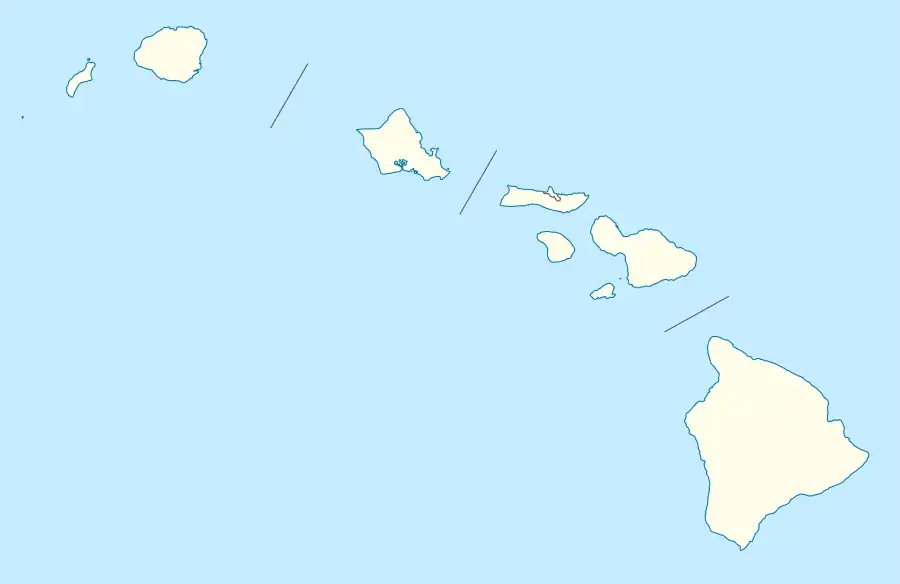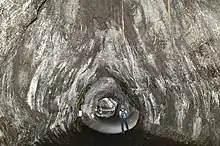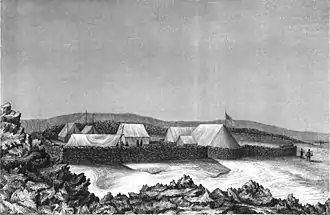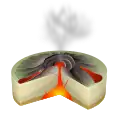| Hawaiʻi Volcanoes National Park | |
|---|---|
 | |
 Location in the Hawaiian Islands | |
| Location | Hawaii County, Hawaii, United States |
| Nearest city | Hilo |
| Coordinates | 19°23′N 155°12′W / 19.383°N 155.200°W |
| Area | 344,812 acres (1,395.40 km2)[1] |
| Established | August 1, 1916 |
| Visitors | 1,580,961 (in 2022)[2] |
| Governing body | National Park Service |
| Website | Hawaiʻi Volcanoes National Park |
| Criteria | Natural: viii |
| Reference | 409 |
| Inscription | 1987 (11th Session) |
Hawaiʻi Volcanoes National Park is an American national park located in the U.S. state of Hawaii on the island of Hawaii. The park encompasses two active volcanoes: Kīlauea, one of the world's most active volcanoes, and Mauna Loa, the world's largest shield volcano. The park provides scientists with insight into the development of the Hawaiian Islands and access for studies of volcanism. For visitors, the park offers dramatic volcanic landscapes, glimpses of rare flora and fauna, and a view into the traditional Hawaiian culture connected to these landscapes.
The park was originally established on August 1, 1916, as Hawaii National Park, which was then split into this park and Haleakalā National Park. In recognition of its outstanding natural values, Hawaiʻi Volcanoes National Park was designated as an International Biosphere Reserve in 1980 and a World Heritage Site in 1987.[3] In 2012, the park was depicted on the 14th quarter of the America the Beautiful Quarters series.
On May 11, 2018, the park was closed to the public in the Kīlauea volcano summit area, including the visitor center and park headquarters, due to explosions and toxic ash clouds from Halemaʻumaʻu, as well as earthquakes and road damage.[4][5] Portions of the park, including the visitor center, reopened to the public on September 22, 2018.[6][7] As of early 2022, most of the park is open; however, some road segments and trails as well as the Jaggar Museum of the Hawaiian Volcano Observatory are still closed to visitors.[4]
Eruptive activity, ground collapses and explosions in the park ceased in early August 2018, and the lull in eruptive activity at Kīlauea continued[8] until an eruption on December 20, 2020, at the Halemaʻumaʻu crater.
Environment

The park includes 323,431 acres (505.36 sq mi; 1,308.88 km2) of land.[9] Around half of the park (130,790 acres (529 km2)) was designated the Hawaii Volcanoes Wilderness area in 1978, providing solitude for hiking and camping.[10] Wilderness designation covers the northwestern extension of the National Park, including Mokuaweoweo, the summit of the volcano Mauna Loa. In the southwestern portion of the park, a large chunk of wilderness includes several miles of coastline and a small portion southeast of the visitors center. The park encompasses diverse environments from sea level to the summit of the Earth's most massive active volcano, Mauna Loa, at 13,679 feet (4,169 m). Climates range from lush tropical rain forests, to the arid and barren Kaʻū Desert.
Recently eruptive sites include the main caldera of Kīlauea and a more active but remote vent called Puʻu ʻŌʻō.[11]
The main entrance to the park is from the Hawaii Belt Road. The Chain of Craters Road leads to the coast, passing several craters from historic eruptions. The road had continued to another park entrance near the town of Kalapana, but that portion is covered by a lava flow, and is only available as an emergency evacuation route. The park's Kahuku District is accessible via Kahuku Road off Highway 11 near mile marker 70.
Climate
| Climate data for Hawaiʻi Volcanoes National Park Headquarters, Hawaii, 1991–2020 normals, extremes 1949–2015 | |||||||||||||
|---|---|---|---|---|---|---|---|---|---|---|---|---|---|
| Month | Jan | Feb | Mar | Apr | May | Jun | Jul | Aug | Sep | Oct | Nov | Dec | Year |
| Record high °F (°C) | 79 (26) |
82 (28) |
80 (27) |
81 (27) |
81 (27) |
83 (28) |
87 (31) |
84 (29) |
85 (29) |
81 (27) |
80 (27) |
81 (27) |
87 (31) |
| Mean maximum °F (°C) | 74.4 (23.6) |
74.7 (23.7) |
74.4 (23.6) |
74.1 (23.4) |
75.8 (24.3) |
76.2 (24.6) |
78.0 (25.6) |
78.8 (26.0) |
77.8 (25.4) |
77.7 (25.4) |
76.1 (24.5) |
75.0 (23.9) |
80.5 (26.9) |
| Mean daily maximum °F (°C) | 68.3 (20.2) |
68.2 (20.1) |
67.5 (19.7) |
68.3 (20.2) |
70.5 (21.4) |
71.3 (21.8) |
72.7 (22.6) |
73.7 (23.2) |
73.2 (22.9) |
72.4 (22.4) |
70.3 (21.3) |
68.2 (20.1) |
70.4 (21.3) |
| Daily mean °F (°C) | 58.8 (14.9) |
58.7 (14.8) |
59.1 (15.1) |
60.1 (15.6) |
61.8 (16.6) |
62.8 (17.1) |
64.1 (17.8) |
64.8 (18.2) |
64.3 (17.9) |
63.7 (17.6) |
62.1 (16.7) |
59.9 (15.5) |
61.7 (16.5) |
| Mean daily minimum °F (°C) | 49.4 (9.7) |
49.3 (9.6) |
50.7 (10.4) |
51.9 (11.1) |
53.0 (11.7) |
54.3 (12.4) |
55.6 (13.1) |
56.0 (13.3) |
55.4 (13.0) |
55.1 (12.8) |
54.0 (12.2) |
51.7 (10.9) |
53.0 (11.7) |
| Mean minimum °F (°C) | 42.6 (5.9) |
42.2 (5.7) |
44.3 (6.8) |
45.9 (7.7) |
47.6 (8.7) |
49.5 (9.7) |
50.3 (10.2) |
50.7 (10.4) |
50.0 (10.0) |
49.5 (9.7) |
47.7 (8.7) |
44.2 (6.8) |
40.6 (4.8) |
| Record low °F (°C) | 34 (1) |
35 (2) |
38 (3) |
40 (4) |
42 (6) |
42 (6) |
45 (7) |
41 (5) |
45 (7) |
45 (7) |
41 (5) |
35 (2) |
34 (1) |
| Average precipitation inches (mm) | 8.77 (223) |
8.15 (207) |
10.27 (261) |
9.16 (233) |
6.46 (164) |
5.10 (130) |
6.29 (160) |
5.91 (150) |
5.98 (152) |
8.19 (208) |
10.59 (269) |
11.37 (289) |
96.24 (2,444) |
| Average precipitation days (≥ 0.01 in) | 21.9 | 20.4 | 25.3 | 26.3 | 25.1 | 25.4 | 25.8 | 25.3 | 23.9 | 24.5 | 26.3 | 25.0 | 295.2 |
| Source 1: NOAA[12] | |||||||||||||
| Source 2: WRCC (mean maxima/minima 1981–2010)[13] | |||||||||||||
History

Kīlauea and its Halemaʻumaʻu caldera were traditionally considered the sacred home of the volcano goddess Pele, and Hawaiians visited the crater to offer gifts to the goddess.
In 1790, a party of warriors, along with women and children who were in the area, were caught in an unusually violent eruption. Many were killed and others left footprints in the lava that are still visible.[14]
The first western visitors to the site, English missionary William Ellis and American Asa Thurston, went to Kīlauea in 1823. Ellis wrote of his reaction to the first sight of the erupting volcano:
″A spectacle, sublime and even appalling, presented itself before us. 'We stopped and trembled.' Astonishment and awe for some moments rendered us mute, and, like statues, we stood fixed to the spot, with our eyes riveted on the abyss below.[15]″

The volcano became a tourist attraction in the 1840s, and local businessmen such as Benjamin Pitman and George Lycurgus ran a series of hotels at the rim.[16] Volcano House is the only hotel or restaurant located within the borders of the national park.
Lorrin A. Thurston, grandson of the American missionary Asa Thurston, was one of the driving forces behind the establishment of the park after investing in the hotel from 1891 to 1904. William R. Castle first proposed the idea in 1903. Thurston, who then owned The Honolulu Advertiser newspaper, printed editorials in favor of the park idea. In 1907, the territory of Hawaii paid for fifty members of Congress and their wives to visit Haleakalā and Kīlauea, including a dinner cooked over lava steam vents. In 1908, Thurston entertained Secretary of the Interior James Rudolph Garfield, and another congressional delegation the following year. Governor Walter F. Frear proposed a draft bill in 1911 to create Kilauea National Park for $50,000. Thurston and local landowner William Herbert Shipman proposed boundaries, but ran into some opposition from ranchers. Thurston printed endorsements from John Muir, Henry Cabot Lodge, and former President Theodore Roosevelt.[17] After several attempts, the legislation introduced by delegate Jonah Kūhiō Kalanianaʻole finally passed to create the park. House Resolution 9525 was signed by Woodrow Wilson on August 1, 1916. Hawaii National Park became the eleventh national park in the United States, and the first in a territory.[18]
As stated in the foundation document:[19]
The purpose of Hawai'i Volcanoes National Park is to protect, study, and provide access to Kīlauea and Mauna Loa, two of the world's most active volcanoes, and perpetuate endemic Hawaiian ecosystems and the traditional Hawaiian culture connected to these landscapes.
Within a few weeks, the National Park Service Organic Act created the National Park Service to run the system.[20] The park was officially renamed Hawaiʻi Volcanoes National Park after being split from Haleakalā National Park on September 22, 1961.
An easily accessible lava tube was named for the Thurston family. An undeveloped stretch of the Thurston Lava Tube extends an additional 1,100 ft (340 m) beyond the developed area and dead-ends into the hillside, but it is closed to the general public.

Painting of Pele

About 1929, D. Howard Hitchcock made an oil painting of Pele, the Hawaiian goddess of fire, lightning, wind, and volcanoes. In 1966, the artist's son, Harvey, donated the painting to the Hawaiʻi Volcanoes National Park, where it was displayed in the visitor center from 1966 to 2005.[21] The painting was criticized for portraying the Hawaiian goddess as a Caucasian.[21]
In 2003, the Volcano Art Center announced a competition for a "more modern and culturally authentic rendering" of the goddess.[22] An anonymous judging panel of Native Hawaiian elders selected a painting by Arthur Johnsen of Puna, Hawaii from 140 entries.[23] In Johnsen's painting, the goddess has distinctly Polynesian features. She is holding a digging stick (ʻōʻō) in her left hand and the egg that gave birth to her younger sister Hiʻiaka in her right hand.[22] In 2005, the Hitchcock was replaced with Johnsen's painting.
Kahuku District expansion

In 2003, an additional 115,788 acres (468.58 km2) of the Kahuku Ranch were added to the park, the largest land acquisition in Hawaii's history. Now named the Kahuku District, the park was enlarged by 56% with the newly acquired land, which is west of the town of Waiʻōhinu and east of Ocean View. The land was purchased for $21.9 million from the estate of Samuel Mills Damon, with financing from The Nature Conservancy.[9]
Recent events
On March 19, 2008, there was a small explosion in Halemaʻumaʻu, the first explosive event since 1924 and the first eruption in the Kīlauea caldera since September 1982. Debris from the explosion was scattered over an area of 74 acres (30 ha). A small amount of ash was also reported at a nearby community. The explosion covered part of Crater Rim Drive and damaged Halemaʻumaʻu Overlook. The explosion did not release any lava, which suggests to scientists that it was driven by hydrothermal or gas sources.[24]

This explosion event followed the opening of a major sulfur dioxide gas vent, greatly increasing levels emitted from Halemaʻumaʻu. The dangerous increase of sulfur dioxide gas prompted closures of Crater Rim Drive between the Jaggar Museum south/southeast to Chain of Craters Road, Crater Rim Trail from Kīlauea Military Camp south/southeast to Chain of Craters Road, and all trails leading to Halemaʻumaʻu, including those from Byron Ledge, ʻIliahi (Sandalwood) Trail, and Kaʻū Desert Trail.[25]
In mid-May 2018, the Kīlauea District of the park was closed due to explosive eruptions at Halemaʻumaʻu, though the Kahuku District remained open. The Kīlauea District, including the visitor center, reopened to the public on September 22, 2018.[6][7] Eruptive activity, ground collapses and explosions in the park had ceased in early August. At the summit, seismicity and deformation are negligible. Sulfur dioxide emission rates at both the summit and the Lower East Rift Zone are drastically reduced; the combined rate is lower than at any time since late 2007. Earthquake and deformation data show no net accumulation, withdrawal, or significant movement of subsurface magma or pressurization as would be expected if the system was building toward a resumption of activity.[8]
A small water pond appeared in Halemaʻumaʻu in the summer of 2019. The pond deepened and enlarged into a small lake since it was first observed, measuring 160 feet (49 m) deep as of December 1, 2020. An eruption in the crater that began on December 20, 2020, boiled away the water lake completely and began to partially refill the crater with lava.[26]
As of 2022, most of the park is open, although some road segments, trails, and the Jaggar Museum of the Hawaiian Volcano Observatory remain closed.[4] The Thurston Lava Tube (Nāhuku) was reopened to the public on February 21, 2020. Several large rockfalls were cleared and sensors were installed to monitor new cracks, along with improvements to water drainage and parking. The rockfalls and cracks had been caused by some of the 60,000 earthquakes recorded during the Kīlauea eruption.[27]
In 2022, the Mauna Loa volcano erupted, after many years. [28]
Pohue Bay expansion
The park expanded in 2022 when The Trust for Public Land transferred its ownership of 16,451-acre Pohue Bay and surrounding land (6,657 ha) to the National Park Service.[29] Pōhue Bay is home to numerous well-preserved and significant Hawaiian cultural sites, including the largest recorded abrader quarry in Hawaiʻi, lava tubes, burial site, mauka-makai (mountain to sea) trails, fishing shrines, remains of once-thriving coastal villages, and petroglyphs. A well-preserved portion of the Ala Kahakai National Historic Trail or Ala Loa, an ancient coastal trail system, hugs the coastline.[30]
The Pōhue coastline is critical habitat for federally listed endangered Hawaiian species, including the Hawaiian hawksbill turtle (honu‘ea) and Hawaiian monk seal. Rare endemic opae'ula (red shrimp) live in the area’s anchialine ponds, and the bay is often frequented by native and migratory birds, including ʻiwa (frigate bird), koaʻe kea (white tailed tropic bird), kōlea (golden plover), 'ulili (wandering tattler) and ʻaukuʻu (black crowned night heron).[30]
Historic places

Several of the National Register of Historic Places listings on the island of Hawaii are located within the park:
- 1790 Footprints
- Ainahou Ranch
- Ainapo Trail
- Kīlauea Crater
- Puna-Kāʻu Historic District
- Volcano House
- Whitney Seismograph Vault No. 29 at the Hawaiian Volcano Observatory
- Wilkes Campsite
Visitor center and museums

The main visitor center, located just within the park entrance at 19°25′46″N 155°15′25.5″W / 19.42944°N 155.257083°W, includes displays and information about the features of the park. The nearby Volcano Art Center, located in the original 1877 Volcano House hotel, is listed on the National Register of Historic Places and houses historical displays and an art gallery.
The Thomas A. Jaggar Museum, now closed due to damage from the 2018 eruptive events, is located a few miles west on Crater Rim Drive. The museum featured more exhibits and a close view of Kīlauea's active vent Halemaʻumaʻu. The museum is named after scientist Thomas Jaggar, the first director of the Hawaiian Volcano Observatory, which adjoins the museum. The observatory itself is operated by the U.S. Geological Survey and is not open to the public.
The Kilauea Military Camp provides accommodations for U.S. military personnel.[31] Volunteer groups also sponsor events in the park.[32]
Superintendents
National park superintendents:[33][34]
- 1922–1922 — Albert O. Burkland
- 1922–1926 — Thomas Boles
- 1926–1926 — Albert O. Burkland
- 1927–1928 — Richard T. Evans
- 1928–1931 — Thomas J. Allen
- 1931–1933 — Ernest P. Leavitt
- 1933–1946 — Edward G. Wingate
- 1946–1946 — Gunnar O. Fagerlund
- 1946–1953 — Francis R. Oberhansley
- 1953–1959 — John B. Wosky
- 1959–1965 — Fred T. Johnston
- 1965–1967 — Glen T. Bean
- 1967–1970 — Daniel J. Tobin
- 1970–1971 — Gene J. Balaz
- 1971–1975 — G. Bryan Harry
- 1975–1978 — Robert D. Barbee
- 1979–1987 — David B. Ames
- 1987–1987 — James F. Martin
- 1987–1993 — Hugo H. Huntzinger
- 1993–2004 — James F. Martin
- 2004–2019 — Cynthia Orlando
- from 2019 — Rhonda Loh.
See also
References
- ↑ National Park Service Acreage Reports
- ↑ "Annual Park Ranking Report for Recreation Visits in: 2022". nps.gov. National Park Service. Retrieved July 23, 2023.
- ↑ "Hawai'i's Only World Heritage Site". Hawai'i Volcanoes National Park web site. National Park Service. Retrieved December 2, 2009.
- 1 2 3 "Area Closures, Advisories, Drones/Unmanned Aircraft & Other Policies". nps.gov. National Park Service. March 8, 2019. Retrieved March 11, 2019.
- ↑ "Volcano park closed for record stretch due to Kilauea eruption". May 28, 2018.
- 1 2 "Volcanoes park reopening good news for Big Island". August 23, 2018.
- 1 2 "Visitors flock to reopened Hawai'i Volcanoes National Park". September 23, 2018.
- 1 2 "Hawaiian Volcano Observatory Weekly Update". volcanoes.usgs.gov. U.S. Geological Survey. March 5, 2019. Retrieved March 11, 2019.
- 1 2 "2008 Business Plan" (PDF). Hawaii Volcanoes National Park. National Park Service. Retrieved December 2, 2009.
- ↑ "Wilderness Connect". wilderness.net. Retrieved August 31, 2019.
- ↑ "Kilauea Status Page". HVO. USGS.
- ↑ "Summary of Monthly Normals 1991-2020". National Oceanic and Atmospheric Administration. Retrieved June 11, 2021.
- ↑ "HAWAII VOL NP HQ 54, HAWAII (511303)". Western Regional Climate Center. Retrieved June 11, 2021.
- ↑ Nakamura, Jadelyn (2003). "Keonehelelei – the falling sands" (PDF). Hawaii Volcanoes National Park Archaeological Inventory of the Footprints Area.
- ↑ "Early Kilauea Explorations". Hawaii Nature Notes number 2. National Park Service. November 1953. Archived from the original on October 23, 2012.
- ↑ "The Volcano House". Hawaii Nature Notes number 2. National Park Service. November 1953. Archived from the original on October 23, 2012.
- ↑ "The Park Idea". Hawaii Nature Notes number 2. National Park Service. November 1953. Archived from the original on October 23, 2012.
- ↑ "The Final Thrust". Hawaii Nature Notes number 2. National Park Service. November 1953.
- ↑ "Foundation Document Hawai'i Volcanoes National Park" (PDF). National Park Service. January 2017. p. 5. Retrieved January 26, 2021.
- ↑ "The National Park Service Organic Act". statutes of the 64th United States Congress. National Park Service. August 25, 1916.
- 1 2 Rod Thompson (July 13, 2003). "Rendering Pele: Artists gather paints and canvas in effort to be chosen as Pele's portrait maker". Honolulu Star-Bulletin. Retrieved January 8, 2010.
- 1 2 Thompson, Rod (August 15, 2003). "Winning Vision of Pele, an Unusual Take". Honolulu Star Bulletin. p. A3.
- ↑ "Fresh face put on volcano park | the Honolulu Advertiser | Hawaii's Newspaper".
- ↑ "Explosive eruption in Halemaʻumaʻu Crater, Kilauea Volcano". HVO. USGS. Archived from the original on March 23, 2008.
- ↑ "Closed Areas". Hawai'i Volcanoes National Park web site. National Park Service. Archived from the original on February 9, 2010. Retrieved December 2, 2009.
- ↑ Bernardo, Rosemarie (December 21, 2020). "No threat to public as Kilauea volcano eruption inside Halemaumau Crater stabilizes". Honolulu Star-Advertiser.
- ↑ "Popular lava tube is open". nps.gov. National Park Service. February 21, 2020. Retrieved February 26, 2020.
- ↑ "Thousands flock to Mauna Loa for selfies during dramatic eruption". the Guardian. November 30, 2022. Retrieved December 6, 2022.
- ↑ Jones, Caleb (July 12, 2022). "Hawaii national park gets land where ancient villages stood". AP News. Retrieved July 13, 2022.
- 1 2
 This article incorporates public domain material from Pōhue Bay preserved from mauka to makai - Hawaiʻi Volcanoes National Park. U.S. National Park Service. July 12, 2022.
This article incorporates public domain material from Pōhue Bay preserved from mauka to makai - Hawaiʻi Volcanoes National Park. U.S. National Park Service. July 12, 2022. - ↑ "Kilauea Military Camp at Kilauea Volcano, a Joint Services Recreation Center". official web site. Retrieved December 2, 2009.
- ↑ "Friends of Hawai'i Volcanoes National Park". official web site. Retrieved December 2, 2009.
- ↑ Historic Listing of National Park Service Officials: Superintendents of National Park System Areas, Hawaii. Last Modified: 2000.
- ↑ New Superintendent Named For Hawaii Volcanoes National Park. National Park Service Press Release: Jan. 5, 2004.
External links
- Official website
 of the National Park Service
of the National Park Service - "Hawaiʻi Volcanoes National Park". Geographic Names Information System. United States Geological Survey, United States Department of the Interior.
- Hawaiian Volcano Observatory
- Hawaii Volcanoes National Park Information: Photo Gallery, Volcano Live Cam, Eruption Update and Park Information.
- Hawai'i Volcanoes publication index
- Hawaii Volcanoes Incident Reports record
Historic American Engineering Record
- Historic American Engineering Record (HAER) No. HI-47, "Hawaii Volcanoes National Park Roads, Volcano, Hawaii County, HI", 6 photos, 20 measured drawings, 116 data pages, 1 photo caption page
- HAER No. HI-76, "Hawaii Volcanoes National Park Water Collection System, Hawaii Volcanoes National Park, Volcano, Hawaii County, HI", 51 photos, 40 measured drawings, 43 data pages, 5 photo caption pages
- HAER No. HI-48, "Crater Rim Drive, Volcano, Hawaii County, HI", 17 photos, 1 color transparency, 3 data pages, 3 photo caption pages
- HAER No. HI-49, "Chain of Craters Road, Volcano, Hawaii County, HI", 7 photos, 1 color transparency, 3 data pages, 2 photo caption pages
- HAER No. HI-50, "Mauna Loa Road, Volcano, Hawaii County, HI", 13 photos, 1 color transparency, 3 data pages, 2 photo caption pages
- HAER No. HI-51, "Hilina Pali Road, Volcano, Hawaii County, HI", 8 photos, 1 color transparency, 3 data pages, 2 photo caption pages
Historic American Buildings Survey
- Historic American Buildings Survey (HABS) No. HI-523, "Namakani Paio Campground, Highway 11, Volcano, Hawaii County, HI", 6 photos, 4 data pages, 1 photo caption page


